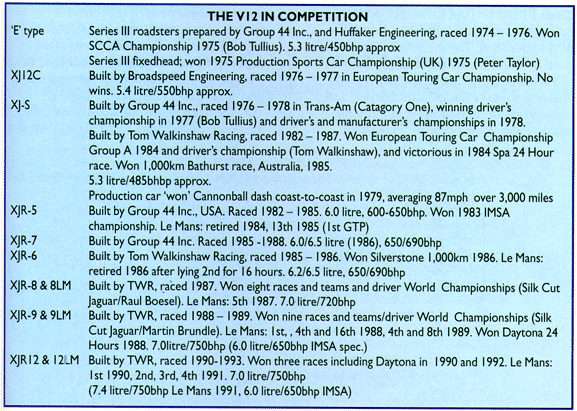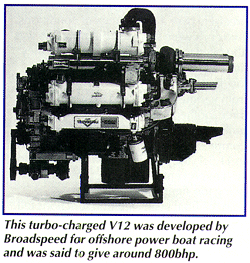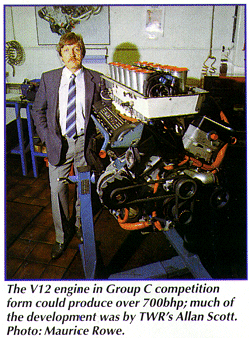|
|
 |
[ Main ] [ 1 ] [ 2 ]
[ 3 ] [ 4 ] [ 5 ] [ 6 ] [ 7 ] [ 8 ] [ 9 ] [ 10 ] [ 11 ] |
Mechanical tribulationsBy and large the V12 was a very reliable engine, as one would expect, but it was not without problems although few were really serious. The crankshaft was pretty well "bomb proof" being a substantial forging from EN16T steel and Tuftrided to create a hard wear resistant surface. Overlap of the main and crank journals was sufficient to permit straight through oil drillings (Fig. 4), carefully worked out to deposit oil at the optimum position to lubricate the crank pins under load. The dreadful sludge traps used on the XK were pointedly avoided. The rope seal at the rear main bearing was never a very happy arrangement and if it dried out through prolonged standing would either leak or worse, rub on the crank and heat it sufficiently to cause failure of the rear bearing, but such problems were rare and later engines had a proper neoprene seal anyway. Of more concern was a tendency for crank pulleys to work loose, fret and cause damage to the locating keyway. This never seemed to happen on early engines yet those made during the 1980s were susceptible. Perhaps the compression pressures of the HE induced some peculiar torsional loading which was not present before.It has been said that the open deck construction of the cylinder block, chosen to simplify the casting process, lacked rigidity. This is true but the multiplicity of studs to clamp the cylinder heads in place gave ample integrity to the completed structure. Main bearing shells would sometimes display witness marks indicating some movement but this never caused trouble in normal operation. On the other hand the abnormal loads generated by a bearing failure could certainly cause enough distortion to necessitate line-boring before fitting a new crank and bearings. Fortunately bearing failures were exceedingly rare and usually followed some sort of neglect. The generous spacing between cylinder bores is perhaps a matter for debate but then again the substantial structure and the volume of coolant therein may well have contributed to the refinement for which the engine was noted by absorbing vibrations. Certainly it is possible to open up the bore size from the standard 90mm to 98mm and to swing a crank throw in excess of 90mm instead of the original 70mm (98mm by 90mm gives 8.1 litres, but with a bit of work 9 litres would be feasible) but the bigger engines hardly ever seem as sweet as the original 5.3. Most observers would say that the final 6 litre (78.5mm stroke) was a bit rough but what is puzzling is that one or two experimental (84 mm stroke) 6.4s built in the 1970s ran like 5.3s. No modern engine would be designed with so much capability for stretching and ultimately this may have sealed the V12s fate. Rapid warm-up is essential for compliance with modern emissions legislation and an engine system that contains 5 or 6 gallons of coolant, as in the case of the V12 Jaguar, is struggling under a hopeless handicap. At the front of the crank was mounted the epicyclic oil pump - an unusual choice which absorbed a fair amount of power, but apart from some noise problems in the early days it gave no trouble at all. Next to it was the timing sprocket from which the duplex timing chain had a long run round both camshaft sprockets and the central jack shaft. Some chain thrash was evident initially but with the aid of visual investigation via windows in the timing cover, damper pads were soon in place to get rid of it. In fact the timing chain of the V12 probably has an easier time than most with plenty of overlap of both the firing impulses from the crankshaft and the torsional loading from the camshafts. The design of the blade chain tensioner is more questionable. Attractively simple, it works well for most of the time with a clever one-way jamming arrangement which takes up any slack, with a simple means of disengagement if the chain needs to be relaxed for repair work. The trouble is that if it starts to slip it soon becomes useless and then a major engine strip is needed to replace it. |

|

[ Main ] [ 1 ] [ 2 ]
[ 3 ] [ 4 ] [ 5 ] [ 6 ]
[ 7 ] [ 8 ] [ 9 ] [ 10 ]
[ 11 ]
![]()
| © Nick Johannessen / JagWeb 1998 |


